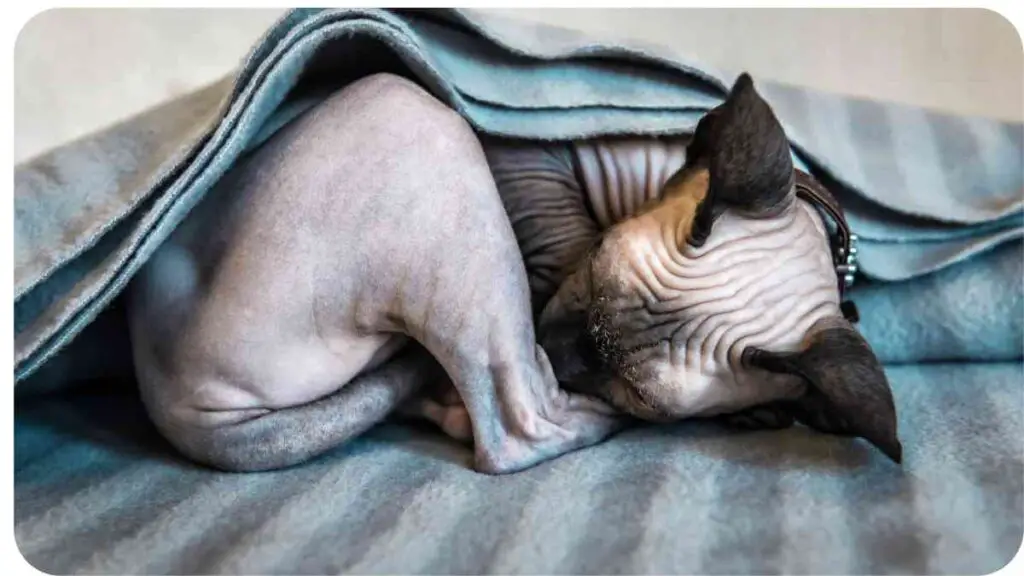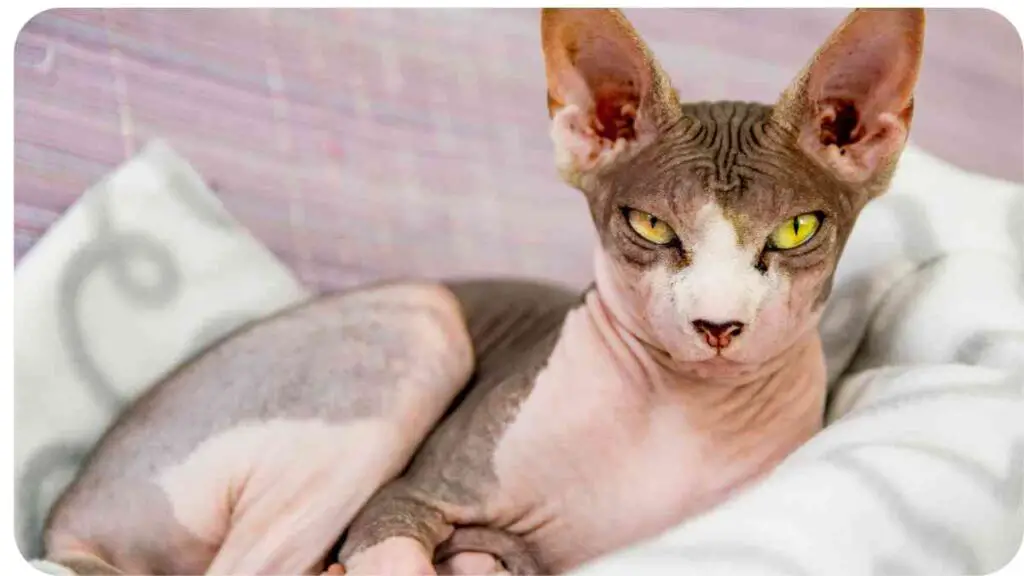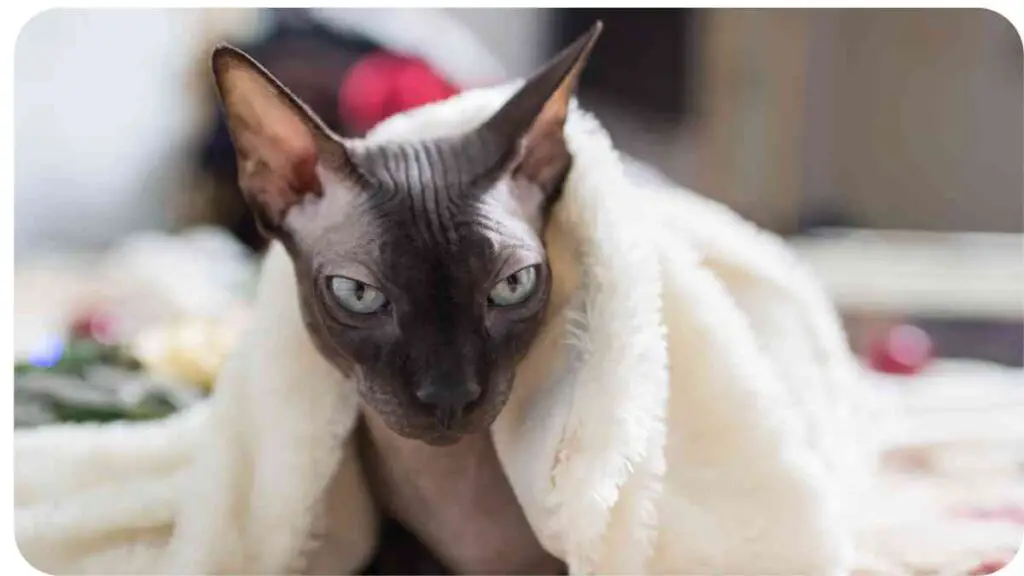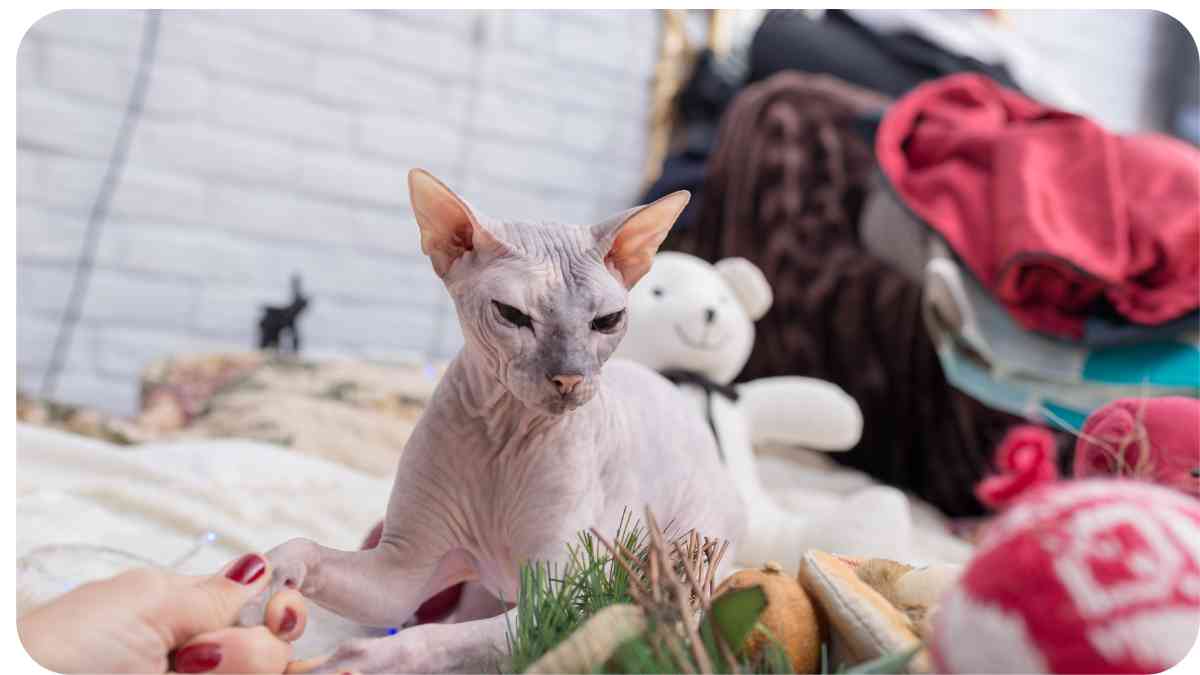Ever wondered why your Sphynx cat seems to nap endlessly? Uncover the secrets behind their adorable slumber with insights into their genetic makeup, environmental influences, and health considerations.
In this guide, we’ll explore the factors affecting your Sphynx cat’s sleep patterns, providing practical tips to ensure their well-being and optimize their rest.
| Takeaways |
|---|
| Sphynx cats have unique sleep patterns and require ample rest. |
| On average, Sphynx cats sleep for about 14 to 16 hours per day. |
| Factors such as age, health, and environment can influence sleep patterns. |
| Providing a comfortable and warm sleeping area is essential for Sphynx cats. |
| Observing and understanding your Sphynx cat’s sleep behaviors can help ensure their well-being. |
Understanding the Natural Sleep Patterns of Sphynx Cats

As a devoted Sphynx cat owner, you’ve likely noticed your feline companion’s penchant for prolonged naps. This behavior is characteristic of their laid-back and independent nature. Sphynx cats, known for their laziness, can spend up to 16 hours per day in slumber, constituting a substantial portion of their 24-hour cycle.
These unique felines exhibit the flexibility to sleep on their back or stomach, much like other cat breeds. However, unlike their furry counterparts, Sphynx cats’ thin paw pads don’t obstruct light when they sleep face up.
The absence of facial fur enhances the intimacy of their nap sessions, with nothing to shield you from the sight of your adorable bald companion blissfully dozing in their preferred nap spot—often conveniently located near their food and water sources.
If you’re curious about the average weight of Sphynx cats and want to ensure you’re providing the best care, our comprehensive guide on how much does the average Sphynx cat weigh? has all the information you need. Discover the factors that influence their weight and learn what’s considered healthy for these unique feline companions.
Creating a Comfortable Environment for Your Sphynx Cat
Ensuring the well-being of your Sphynx cat goes beyond providing cozy spots—it involves understanding and managing their sensitivity to temperature changes. Sphynx cats are particularly attuned to variations in climate, making it essential for owners to take proactive measures, especially in warm climates.
Living in a warm environment poses challenges for Sphynx cats, necessitating careful consideration. It’s advisable to keep them indoors or in a sheltered area, shielding them from the potential discomfort of high temperatures. Direct exposure to sunlight should be limited, with outdoor excursions restricted during extreme temperatures, especially when the mercury climbs to 80°F or higher.
Creating an indoor haven for your Sphynx cat involves maintaining a cool room with minimal direct heat or air conditioning. These measures cater to their vulnerability to heat, ensuring a comfortable and stress-free environment for your feline companion. By prioritizing their temperature preferences, you contribute to their overall well-being and happiness.
| Environmental Factors | Recommendations |
|---|---|
| Enrichment toys | Kong Classic, Catit Senses Play Circuit |
| Scratching surfaces | SmartCat Ultimate Scratching Post, Feliway Scratching Post |
| Climbing opportunities | Armarkat Cat Tree, Cat Craft Three-Tier Cat Tree |
| Window views | K&H Pet Products Kitty Sill, Sunny Seat Window Perch |
| Cozy resting spots | PetFusion Ultimate Cat Bed, K&H Thermo-Kitty Heated Cat Bed |
Age and Sleep Dynamics in Sphynx Cats
Sphynx cats, renowned for their unique charm, exhibit distinctive sleep patterns influenced by various factors, with age playing a pivotal role in shaping these dynamics. As a dedicated Sphynx cat owner, understanding how age impacts your feline companion’s sleep can enhance their well-being and overall quality of life.
- Early Years – Embracing Laziness: In their youth, Sphynx cats often embrace a more carefree and lazy demeanor. Spending a significant portion of their day napping—up to 16 hours—reflects their inherent independent nature. While seemingly excessive, this sleep routine is natural for young Sphynx cats who revel in relaxation.
- Transitioning Years – The Impact of Aging: As Sphynx cats age, their sleep patterns undergo noticeable changes. Older cats may exhibit an increase in sleep duration, a shift attributed to factors such as health conditions, reduced vitality, or simply adapting to a more sedentary lifestyle. The need for additional rest becomes a reflection of their evolving needs.
- Health Considerations – Unveiling Sleep Clues: The amount of sleep a Sphynx cat requires can also serve as a potential indicator of their health. Conditions like arthritis, heart disease, or cancer may prompt older cats to seek more rest. Understanding these cues and addressing potential health concerns ensures proactive care tailored to their individual needs.
- Creating an Ideal Environment – Age-Adaptable Comfort: Crafting a conducive sleep environment gains heightened significance with age. Providing cozy bedding, warm blankets, and a serene setting contributes to the comfort of your aging Sphynx cat. Tailoring the environment to align with their changing preferences fosters a peaceful and rejuvenating sleep experience.
Are you wondering about the lifespan of Sphynx cats? Our article on the average life expectancy of a Sphynx cat provides insights into the factors that can impact their longevity. Gain a better understanding of their health, care requirements, and what you can do to promote a long and happy life for your Sphynx companion.
Safeguarding Your Sphynx Cat from Heat

In regions with scorching temperatures, it’s crucial to prioritize the well-being of your Sphynx cat by implementing smart heat management strategies. Shielding them from the direct impact of the sun’s rays becomes paramount in ensuring their comfort and health.
If you reside in an area with intense heat, provide ample shade for your Sphynx cat, especially during peak sun hours. Beyond the external threat of sun exposure, it’s essential to recognize the potential for overheating even when indoors during excessively hot weather.
To safeguard your feline friend, it’s advisable to limit their exposure to direct sunlight to brief intervals, avoiding prolonged periods that could lead to heat stress. By staying vigilant and proactive in managing hot weather conditions, you contribute to your Sphynx cat’s overall safety and ensure they enjoy a cool and comfortable environment year-round.
Understanding the Impact of Stress on Your Sphynx Cat’s Sleep Patterns
The well-being of your Sphynx cat goes beyond physical aspects, extending to their mental health and emotional state. Stress, a significant factor in feline behavior, can manifest in altered sleep patterns, with increased sleep being a potential indicator.
Identifying sources of stress is crucial for maintaining your Sphynx cat’s mental equilibrium. Common stressors include the introduction of a new pet or person, a change in residence, or even alterations in the environment like adding carpeting or rearranging furniture.
If you observe your Sphynx cat sleeping more than usual, it’s a cue to pay attention to potential stressors in their surroundings. Providing extra comfort, spending quality time, and creating a calming environment can help alleviate stress. By addressing these factors, you contribute to a more content and relaxed atmosphere for your Sphynx cat, fostering a healthier and happier feline companion.
| Symptoms | Solutions |
|---|---|
| Excessive vocalization | Use Feliway diffusers for calming |
| Hiding or withdrawal | Provide a quiet space with Comfort Zone |
| Aggression or irritability | Try Zylkene supplements for relaxation |
| Changes in appetite | Offer Royal Canin Calm diet |
| Inappropriate elimination | Consider using Adaptil calming spray |
Combatting Excessive Sleep
Excessive sleep in your Sphynx cat may be a clear sign of boredom, highlighting the importance of mental stimulation and engagement. These highly intelligent creatures, prone to routines, may succumb to lethargy when not adequately entertained.
Cats, especially those with consistent habits, thrive on predictability. If your busy schedule limits interaction time, your Sphynx cat may resort to increased sleep as a coping mechanism for boredom. To counteract this, establish daily routines that include dedicated playtime, feeding, and social interactions.
Creating a structured environment with predictable activities helps your cat feel secure, reducing the likelihood of boredom-induced stress. By investing time in engaging your Sphynx cat through interactive play, you not only prevent excessive sleep but also foster a dynamic and fulfilling relationship, promoting their overall well-being.
Maintaining proper hygiene is essential for Sphynx cats. In our detailed guide on how often should you wash a Sphynx cat?, you’ll discover expert recommendations and tips for keeping your Sphynx clean and comfortable. Learn about bathing techniques, frequency, and the importance of a proper grooming routine for these hairless beauties.
Monitoring Your Sphynx Cat’s Health
Changes in your Sphynx cat’s sleep patterns, particularly increased duration, could signify underlying health issues requiring prompt attention. It’s imperative to be vigilant and proactive in identifying signs of illness or injury to ensure your feline companion’s well-being.
If you observe your Sphynx cat sleeping more than usual, it’s crucial to take action and consult your veterinarian. Illness or injury can significantly impact your cat’s sleep behavior, necessitating thorough examination and treatment.
In cases of illness, especially if accompanied by a loss of appetite, immediate veterinary care is essential. Your veterinarian may conduct comprehensive assessments, including blood tests and diagnostic procedures, to diagnose the underlying cause. Treatment options may range from medication to surgical intervention, depending on the severity of the condition.
Similarly, injuries requiring medical attention demand swift action. Whether it’s an accident outdoors or an unexpected mishap indoors, prioritize your Sphynx cat’s well-being by seeking urgent veterinary care. X-rays and diagnostic imaging may be necessary to assess the extent of injuries and determine the appropriate course of treatment.
Optimizing Your Sphynx Cat’s Health Through Proper Nutrition

Ensuring the ideal diet for your Sphynx cat is paramount to their overall health and well-being. As obligate carnivores, these unique felines have specific dietary needs that should align with their natural instincts.
To maintain optimal health, prioritize a diet rich in protein and fat for your Sphynx cat. High-protein sources like meat or fish, complemented with quality carbohydrates such as rice or potatoes, form a balanced and nutritious foundation. Additionally, incorporating dairy products like cheese and yogurt helps ensure sufficient calcium intake.
When selecting commercial cat food, exercise caution and read labels meticulously. Manufacturers may include additives like corn meal, potentially compromising the nutritional integrity of the diet.
Equally important is being aware of foods that should be strictly avoided. Chocolate, onions/onion powder/onion soup mix, avocado skins/avocado pits, and caffeine-containing products like coffee or tea can induce digestive distress. While not inherently toxic, these items can lead to health complications if not promptly addressed.
Are you a proud owner of a Sphynx cat or planning to adopt one? Understanding the bathing needs of Sphynx cats is crucial. Check out our informative article on how often do Sphynx cats need to be bathed? to learn about their unique skin care requirements, recommended bathing schedule, and tips for making bath time a pleasant experience for your feline friend.
Nurturing Your Sphynx Cat’s Intellect
Sphynx cats, hailed for their intelligence, curiosity, and activity, require not only physical but also mental stimulation to thrive. Originating from France, where they were kept as pets, Sphynx cats have evolved robust mental skills that necessitate ongoing engagement.
Insufficient mental stimulation can lead to boredom and undesirable behaviors, including furniture scratching and counter climbing. To ensure the mental well-being of your Sphynx cat, consider incorporating various stimulating activities into their daily routine.
Strategies for Mental Stimulation:
- Puzzle Toys: Introduce toys like the Cat Dancer or Catit Treat Maze, offering mental challenges that keep your cat engaged. Concealing treats within these toys adds an extra layer of reward and satisfaction.
- Interactive Games: Foster a bond with your feline companion through games like “fetch” or “tug-of-war.” Not only do these activities enhance the owner-pet relationship, but they also provide essential physical exercise.
- Laser Pointers: Capitalize on the innate hunting instincts of your Sphynx cat by using laser pointers. The irresistible allure of chasing the elusive light stimulates both their mind and body.
- Cat Dancer Toys: Opt for toys that move around, such as the cat dancer, providing dynamic and unpredictable stimuli that captivate your cat’s attention.
- Environmental Enrichment: Explore unconventional methods like putting up posters around the house, adding an element of visual interest that may intrigue and engage your Sphynx cat.
| Challenges | Solutions |
|---|---|
| Boredom and restlessness | Engage in interactive play |
| Destructive behavior | Provide puzzle toys and treat dispensers |
| Attention-seeking | Implement training and enrichment activities |
| Increased stress levels | Offer brain-teaser games and puzzles |
| Lack of mental exercise | Use interactive feeders and toys |
Navigating Hormonal Influences on Your Sphynx Cat’s Sleep Patterns
Hormonal changes contribute significantly to variations in your Sphynx cat’s sleep habits, with distinct differences observed between male and female felines. Understanding these hormonal dynamics provides insights into their sleep patterns.
Female Cats and Sleep Duration: Female cats, in general, may exhibit longer sleep durations compared to their male counterparts. This can be attributed to various hormonal factors, including pregnancy, nursing, and the effects of birth and menopause.
Pregnancy and Nursing: Pregnant or nursing female cats often require additional rest to support the demanding physiological processes associated with these life stages. The energy expended in carrying and caring for kittens can contribute to increased sleep needs.
Hormonal Fluctuations: Beyond specific life events, hormonal fluctuations during birth, nursing, and menopause can impact a female cat’s sleep patterns. These changes may induce variations in energy levels and rest requirements.
Recognizing and accommodating these hormonal influences is essential for providing appropriate care and understanding the natural sleep tendencies of your Sphynx cat. By acknowledging the role of hormones, you contribute to a supportive and nurturing environment that aligns with your cat’s physiological needs at different stages of their life.
Curious about the lifespan of hairless cats? Our comprehensive article on what is the lifespan of a hairless cat provides valuable insights into the average life expectancy of these unique felines. Discover factors that can influence their lifespan and learn how to provide them with the best possible care for a long and healthy life.
Revitalizing Your Sphynx Cat’s Health
Physical activity is integral to the well-being of your Sphynx cat, ensuring they lead a healthy and fulfilling life. If you haven’t already incorporated regular exercise into their routine, now is the opportune moment to introduce activities that invigorate their senses and enhance their vitality.
Outdoor Playtime: Consider taking your Sphynx cat on short walks around the block. Outdoor exploration provides not only physical exercise but also mental stimulation as they engage with their surroundings. Allowing them to roam freely, under safe conditions, allows for a more dynamic and enriching experience.
Indoor Exercise Solutions: For indoor cats or those requiring additional exercise, explore interactive toys tailored to stimulate their senses. Options like laser pointers or feather wands offer engaging experiences that cater to your Sphynx cat’s natural instincts. These toys not only promote physical movement but also provide mental stimulation, contributing to their overall well-being.
Conclusion
In conclusion, understanding the factors influencing your Sphynx cat’s sleep patterns is crucial for fostering their overall well-being. While the average sleep duration for Sphynx cats ranges from 14 to 16 hours per day, individual variations exist based on age, health, and environmental factors.
Prioritize providing ample exercise opportunities to keep your Sphynx cat active and vibrant. Regular walks, outdoor playtime, and interactive toys contribute to their physical and mental stimulation. This not only aids in preventing boredom-related behaviors but also ensures a healthier and more contented feline companion.
Creating a conducive sleep environment is equally vital. Offering a safe and comfortable space, whether through cozy bedding, warm blankets, or quiet corners, enhances your cat’s sleeping experience. Considering their sensitivity to temperature, maintaining an optimal room climate further contributes to a restful slumber.
Ultimately, a holistic approach encompassing exercise, environmental considerations, and attentive care fosters the ideal conditions for your Sphynx cat to enjoy a balanced and fulfilling life. Striking the right balance between play, rest, and comfort ensures a happy and healthy journey for your unique and cherished feline friend.
Further Reading
Sphynx Cat Sleep Patterns: How Much Sleep Do Your Babies Get?: Join the discussion on Sphynx cat sleep patterns and discover how much sleep other Sphynx cat owners’ babies typically get. Gain insights and share experiences within the Sphynx cat community.
Are Sphynx Cats Nocturnal? Exploring the Sleeping Habits of Hairless Felines: Learn more about the sleeping habits of Sphynx cats and whether they are nocturnal. Explore their natural instincts, preferred sleep patterns, and how to create a sleep-friendly environment for your Sphynx companion.
Sphynx Cat Sleeping Position: Decoding Your Hairless Feline’s Resting Postures: Discover the various sleeping positions of Sphynx cats and understand what they indicate about their comfort and mood. This article decodes the resting postures of Sphynx cats and helps you better understand your feline friend.
And here’s the FAQs section based on the semantic of the title, with five questions and answers in H3 format:
FAQs
Do Sphynx cats sleep more than other cat breeds?
Sphynx cats have similar sleep requirements to other cat breeds, with an average of 12 to 16 hours of sleep per day. However, individual variations in sleep patterns may occur.
Are Sphynx cats more active at night?
Sphynx cats can be active both during the day and night. While they may exhibit some nocturnal tendencies, their activity levels can vary depending on their age, environment, and individual personality.
What are common sleeping positions for Sphynx cats?
Sphynx cats can sleep in various positions, including curled up, stretched out, or even in a sphynx position with their legs tucked underneath their body. Each position serves a different purpose for comfort and warmth.
Why do Sphynx cats prefer warm sleeping areas?
Sphynx cats lack fur, which makes them more susceptible to feeling cold. They often seek warm sleeping areas to regulate their body temperature and maintain their comfort. Providing cozy spots or blankets can help fulfill this need.
How can I create a comfortable sleep environment for my Sphynx cat?
To create a comfortable sleep environment for your Sphynx cat, consider providing soft bedding, warm blankets, and a quiet space. Additionally, ensure the room temperature is adequately regulated to keep them cozy during sleep.

I’m Dr. Hellen James, a veterinarian who has spent her career working with cats and has seen firsthand how important it is to understand each breed’s unique needs.


